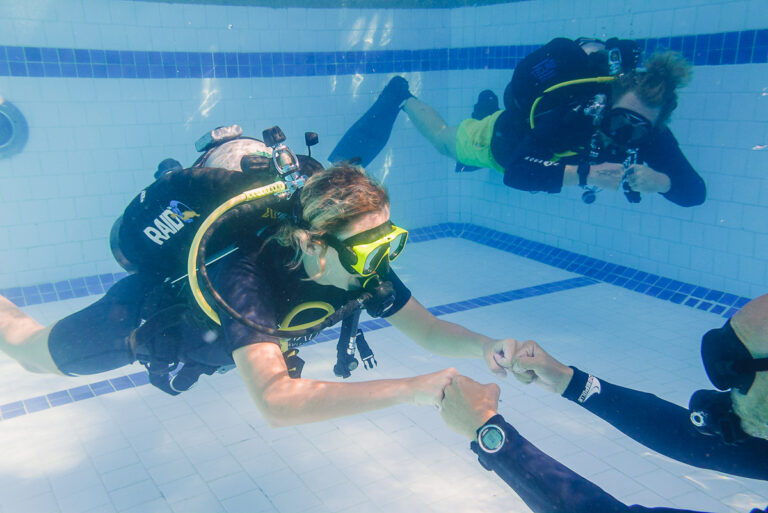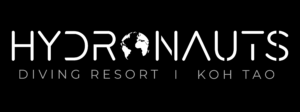Everything you need to know about doing your Open Water diving course on Koh Tao
Hooray, you’ve decided to take an Open Water scuba diving course! 70% of the earth is covered in water, so why not take a look at what you’re missing out on? And scuba diving in Thailand means you can make so much more of your vacation than just sitting on a beach sipping a cocktail. Learning to dive will grant you entrance to a world of wonderment, filled with thousands of species of colorful fish and vibrant coral.
What is an Open Water scuba diving course?
The Open Water course is the first scuba diving certification you can receive as a new diver. While some people refer to the Open Water Course as a “PADI”, that’s not quite accurate. PADI is one brand name among many agencies with a dive training curriculum. Other commonly known agencies are RAID, SSI, NAUI and BSAC, for example.
These dive schools offer different curriculum, but they all offer this first level called Open Water Certification.
The Open Water course takes 3.5 days to complete, so be sure to give yourself time, and stay away from any diving schools promising a shorter course. The time and effort you’ll invest in order to get the most out of your course will guarantee a fun and fulfilling experience, and make you an excellent diver. Plus, you’ll be better prepared to move on to your Advanced Open Water scuba diving course if that’s what you choose to do.
Let’s go on a tour of how Hydronauts will lead you through your Open Water course.
Course structure for a RAID Open Water diver course
There are three main parts of your RAID Open Water diver course:
- Knowledge development
- Confined water skills training (pool training)
- Diving in the open ocean
Knowledge Development: RAID e-Learning
In order to understand the ins and outs of what happens to your body when you go scuba diving, how your equipment works, and what the environment is like while you’re diving, you’ll go through a series of academic sessions.
At Hydronauts, we teach RAID’s diver training curriculum (learn more about RAID here) RAID training offers a mixture of in-class learning and free online e-learning, giving you a chance to learn at your own pace. You will have unlimited access to your Open Water course materials as soon as you sign up. Each chapter of your e-learning is easy to understand and will go over basics on diver safety and equipment and the underwater environment, before moving onto specifics. There are small quizzes along the way to check that you’ve absorbed what you’ve read and make sure you’re comfortable moving forward.
After your first academic session with your instructor, you’ll have a bit of homework. Happily, your homework can all be done online, on your phone, and most definitely at sunset while sipping a fresh coconut.
Learn How to Set Up your Scuba Diving Equipment
Your instructor will review in detail how to set up your diving equipment on a scuba tank and show you how each piece of equipment can be tested to ensure your safety. Once you’ve learned to set up and take apart your equipment, it’s time to jump in the pool and take your first breaths underwater.

At Hydronauts, we teach our courses in state-of-the-art equipment. We also offer a variety of fin and mask styles, as finding the personalized match for your face and buoyancy is extremely useful.
Our diving equipment includes backplate and wing buoyancy control devices and we offer the option to use regulators configured in the long hose and short hose set up. This configuration allows for the most streamlined position in the water making it more comfortable to dive in than traditional equipment set ups commonly used in dive schools. It is modular and can be adjusted so that it is one-size-fits-all. It also offers some unique safety features that improve on more traditional diving equipment.
Blow your First Bubbles - Confined Water Scuba Diving Pool Training
Now it’s time to take the plunge and enjoy your first breaths underwater.
During your pool training, you will be under constant supervision by your instructor as they guide you through a series of scuba skills, including buoyancy control and equipment management like clearing your mask and recovering your regulator. You’ll learn how to hover without sinking to the bottom, how to swim efficiently in the equipment, and just get used to being underwater. You’ll also learn dive safety skills for situations that may arise during a dive, like running low on air and assisting your dive buddy if they have any issues during a dive.
Pool training is an exciting and challenging process of discovering your own abilities in a foreign (but safe) environment. And the best thing about being in a pool? You can stand up at any time if you have a question or concern.
You’ll finish your pool training in 3-4 hours and be ready to get out into the big blue open ocean the next day.
Let’s Go Diving - Boat Dives 1 & 2 in the Open Ocean
On your second morning of the course, you’ll wrap up some final classroom time with your instructor and take your final quiz. You’ll have a short break before packing your dive bag and getting ready for departure from our beachfront resort to the dive boat in Chalok Bay.
Departing from the bay on our dive boat is thrilling – not only is there a lush view of the island, but you’ll experience the electrifying energy of other divers on the boat ready to explore the best dive sites on Koh Tao.
The first ocean dives are meant to introduce you to being underwater and to get comfortable with your surroundings.
Before each of your two dives, you’ll be given a dive briefing by your instructor, where they explain how the dive will go. Every dive has a plan and every diver who gets briefed on that plan will know what to expect, as well as what is expected of them.
Some of the basic skills you learned in the pool will be repeated on your dive. You’ll also learn how to communicate using hand signals, how to enter the water, and how to descend and ascend safely and comfortably.
Your first dive will be in shallow water, where you’ll be guided by your instructor down a safe line to the dive site. Beginner diving on Koh Tao is common and other divers will give you plenty of space. So take your time and remember to breathe, because once you descend, you’ll find a peaceful majestic scene like nothing you’ve ever experienced.
Your second dive will be a continuation of your first dive, allowing you to improve and practice diving, and becoming even more comfortable in the water.
These dives are not just educational and practical, but they’ll offer plenty of time for you toenjoy the new underwater world you’ve entered.
Completing your Open Water Scuba Diving Course - Boat Dives 3 & 4 in the Open Ocean
Applying the skills you’ve learned in your academics, pool sessions and first dives, you’ll now be able to practice all you’ve accomplished! The final dives of your Open Water course will allow you to dive a bit deeper, and become comfortable with diving for fun. You’ll learn more about our marine life, and why Koh Tao is a mecca for divers seeking an epic underwater adventure.
By your final dive, you’ll have practiced any skills you’d like to improve, learn a bit about navigating underwater and have logged enough time diving to make you confident in your abilities to safely and comfortably jump into the water almost anywhere in the world.
Continuing Your Diving Education
Once certified as an Open Water diver, you’ll be licensed to dive to 20 meters. There are so many incredible diving destinations, from freshwater to saltwater, in warm environments like the tropics or cold environments like mountain lakes. You’ll be certified to discover endless species of marine life and you’ll meet fascinating people all over the world who share a passion for the ocean and scuba diving.
Sticking around Koh Tao for a while? As a certified diver, you’ll be able to enjoy the best dive sites in Koh Tao by signing up for some Fun Dives after your course, or, if you know you want to continue diving education, you can sign up for the Explorer 30 Advanced scuba diving course. Fun Dives are highly encouraged after your Open Water course as they are the best way to practice what you’ve learned and to explore this new environment.
At Hydronauts Diving Resort, we have everything you need to continue your education – we have recreational diving courses like the Explorer 30 Advanced course, Master Rescue course, the Deep 40 and Enriched Air Diving (Nitox) course, as well as the Divemaster professional course. We also offer underwater photography courses and marine conservation courses and internships through our Marine Biologist partner organization, Global Reef.
Our beautiful beachfront resort is the perfect place to stay while you learn to scuba dive. With the dive center, training pool, restaurant, and beach bar on site, you’ll have everything you need right outside your front door.
Scuba Diving Course Prerequisites and Requirements
The Open Water scuba diving course requires no previous diving experience. There are a few prerequisites, though.
Being 15 years old is a minimum requirement for the normal Open Water course, but don’t worry. 12-14 year olds can participate in the same curriculum but are certified to 18 meters depth until they reach the age of 15 when they are automatically upgraded to a 20 meter diver.
Kids 8 and older also have some options to begin blowing bubbles. We offer a Cadet Try Diver course for kids aged 8-12. E-mail us to learn more about kids’ diving courses as well as family course options.
You will also need to complete a short medical questionnaire that contains a few questions regarding underlying medical conditions that may prevent you from diving. Should you need to be examined by a medical professional to confirm you’re fit to dive, Koh Tao has many clinics specializing in evaluating if these will prohibit your ability to take the course. Most people pass this evaluation, but it’s just a safety measure to make sure you’re fit to dive.
The last requirement is that you must be able to swim 200 meters and float for 10 minutes without any swim aids, or a bit longer if you do require swim aids. You’ll do this in our on-site training pool and your instructor will be with you encouraging you along the way.
Where Do I Sign Up?
Right here! Fill in the form and you’ll get an email from us in 12-24 hours to get you started. And feel free to fill in the form to ask us some more questions. You can also email us at info@hydronautsdiving.com or call or WhatsApp us at +66 080-065-8782.
We look forward to diving with you!



